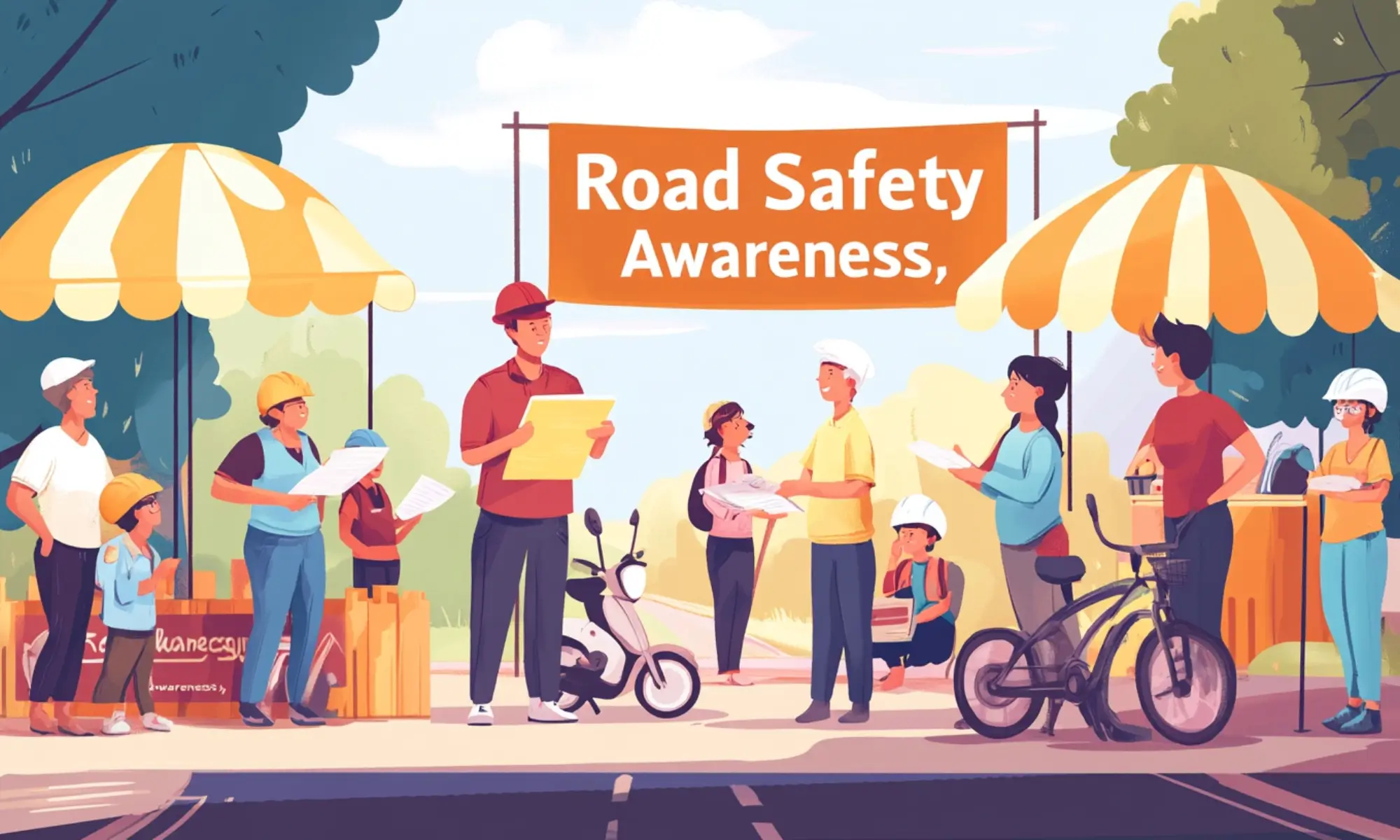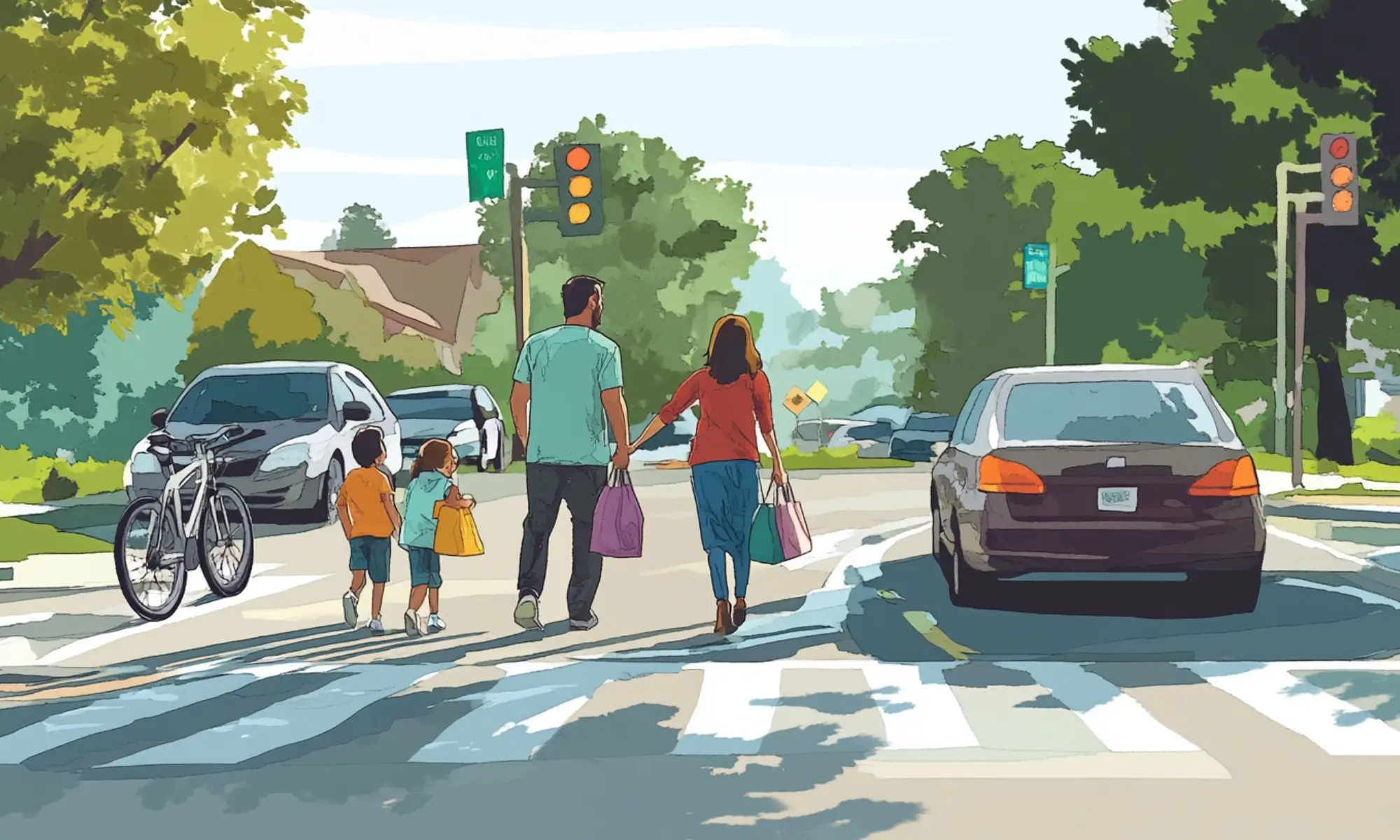Welcome to our blog on developing road safety skills, a vital topic that cannot be emphasized enough. As our roads become increasingly congested, the importance of possessing and implementing road safety skills for drivers, pedestrians, and cyclists has never been more crucial. This article provides comprehensive guidelines to help you enhance your road safety skills, contributing to a safer and more responsible transportation environment.
Road safety skills are indispensable for all road users, whether drivers, pedestrians, or cyclists. Every year, millions of lives are lost or permanently altered due to road accidents. According to the World Health Organization, approximately 1.35 million people die in road traffic accidents yearly, and between 20 and 50 million people suffer non-fatal injuries, often resulting in long-term disabilities. These staggering statistics highlight the need for enhanced road safety awareness and skills.
The consequences of road accidents are far-reaching, impacting the victims, their families, communities, and the economy. Besides the immeasurable emotional and psychological toll, road accidents often incur substantial financial burdens regarding medical expenses, lost productivity, and property damage.
This article aims to provide practical guidelines for developing road safety skills, ultimately reducing the likelihood of accidents and their devastating consequences. We will explore essential safety practices, techniques, and strategies that drivers, pedestrians, and cyclists can implement to improve their safety and that of others on the road. Join us as we embark on this vital journey towards better road safety, and together, let’s make our roads safer for everyone.

How To Develop Road Safety Skills? 10 Essential Road Skills
Developing road safety skills is essential for all road users, including pedestrians, cyclists, and drivers. Here are 10 road safety skills to help you stay safe on the roads:
1. Understanding Traffic Rules And Regulations
A solid foundation in road safety begins with a thorough understanding of traffic rules and regulations. These laws are designed to maintain order and prevent accidents, ensuring all road users can safely share the road. Here, we will explore three key points to help you become well-versed in traffic rules and regulations.
Familiarize Yourself with Traffic Rules in Your Area:
Traffic rules may vary depending on your location. Familiarizing yourself with your region or country’s specific rules and regulations is essential. This information can usually be found in your local driver’s handbook, on government websites, or through driving schools. Be sure to keep yourself updated on any changes or updates to these rules, as they may evolve over time.
Learn About Road Signs and Their Meanings:
Road signs are integral to the traffic system, providing vital information and guidance to road users. They come in various shapes, colors, and symbols, each with a specific meaning. Take the time to learn and understand the different road signs and their meanings, as this knowledge will allow you to navigate the road safely and effectively. Some common road sign categories include:
- Warning signs: Indicate potential hazards or changes in road conditions ahead.
- Regulatory signs: Inform road users of the rules and regulations that must be followed.
- Guide signs: Provide information about routes, destinations, and distances.
- Construction and work zone signs: Alert drivers of ongoing construction or maintenance work.
Pay Attention to Speed Limits and Other Regulations:
Speed limits and other regulations, such as yielding to pedestrians or obeying traffic signals, are crucial in maintaining road safety. Adhering to the speed limit limits reduces the risk of accidents and helps avoid fines and penalties. Remember that speed limits may vary based on location, road type, and weather conditions. Always stay vigilant for posted speed limit signs and adjust your speed accordingly.
In addition to speed limits, other regulations play a significant role in ensuring road safety. Some examples include:
- Stopping or yielding at stop signs and yield signs.
- Using turn signals when changing lanes or making turns.
- Adhering to rules regarding right-of-way, particularly at intersections and pedestrian crossings.
- Following regulations for using mobile devices or other distractions while driving.
- Complying with seatbelt and child restraint laws.
By taking the time to understand and follow traffic rules and regulations, you can significantly enhance your road safety skills. This knowledge will help you make informed decisions, avoid accidents, and ensure your well-being.

2. Defensive Driving Techniques
Defensive driving techniques are crucial for developing road safety. They involve being aware of your surroundings, anticipating potential hazards, and taking necessary precautions to avoid accidents.
Maintaining a safe following distance is an essential aspect of defensive driving. It allows you to react to sudden stops or changes in traffic flow, reducing the risk of rear-end collisions. Generally, keeping at least a two-second gap between your vehicle and the vehicle in front of you is recommended. This gap should be increased in adverse weather conditions or when driving at high speeds.
Being aware of your surroundings and anticipating potential hazards is another critical aspect of defensive driving. This involves paying attention to other vehicles, pedestrians, and cyclists on the road and being prepared to react to sudden changes in traffic flow. It’s also essential to anticipate potential hazards such as merging traffic, intersections, and sharp turns.
Signaling your intentions early is another important aspect of defensive driving. Signalling your turns, lane changes, and stops early can give other drivers and pedestrians more time to react and avoid accidents.
Finally, adjusting your driving according to weather and road conditions is important to defensive driving. Adverse weather conditions such as rain, snow, and fog can affect visibility and road conditions, making driving more challenging. Adjusting your speed, increasing your following distance, and using appropriate driving techniques can help you stay safe on the road.
3. Pedestrian Safety
Pedestrian safety is an essential skill to develop for road safety. Unfortunately, pedestrian accidents are common, and it’s important to take necessary precautions to avoid them.
Using crosswalks and pedestrian signals is crucial for pedestrian safety. Crosswalks are designed to help pedestrians cross the street safely, and it’s important to use them whenever possible. Pedestrian signals indicate when it’s safe to cross the street and should always be obeyed.
Making eye contact with drivers before crossing the street is another important aspect of pedestrian safety. Eye contact can help ensure that drivers see you and know you’re crossing the street. This is especially important when crossing at intersections where drivers may be turning.
Staying visible and avoiding distractions is also essential for pedestrian safety. Wear bright or reflective clothing when walking at night or in low-light conditions, and avoid distractions such as texting or using headphones.
Teaching children about road safety from a young age is also important for developing pedestrian safety skills. Children should be taught to use crosswalks and pedestrian signals, make eye contact with drivers before crossing the street, stay visible, and avoid distractions while walking. Children should also be supervised when walking near or crossing streets until they are old enough to do so safely.

4. Cyclist Safety
Cyclist safety is a critical aspect of road safety, and developing the necessary skills can help reduce the risk of accidents and injuries.
Following traffic rules applicable to bicycles is essential to cyclist safety. Cyclists should ride on the right-hand side of the road, in the same direction as traffic, and obey all traffic signals and signs. This includes stopping at red lights and stop signs and yielding to pedestrians.
Appropriate safety gear, such as helmets and reflective clothing, is also essential for cyclist safety. Helmets can help reduce the risk of head injuries in an accident. In contrast, reflective clothing can help increase visibility, especially when cycling in low-light conditions.
Maintaining your bicycle and ensuring it is equipped with lights and reflectors is also important for cyclist safety. Regular maintenance can help ensure your bike is in good working condition. In contrast, lights and reflectors can help increase visibility and reduce the risk of accidents, especially when cycling at night.
Another important aspect of cyclist safety is riding defensively and communicating your intentions to other road users. This involves being aware of your surroundings, anticipating potential hazards, and taking necessary precautions to avoid accidents. Cyclists should also use hand signals to communicate their intentions to drivers and other road users, such as when turning or changing lanes.
By following these safety tips, cyclists can help reduce the risk of accidents and injuries and ensure a safer cycling experience on the road.
5. Driver’s Education and Training
Driver education and training are important aspects of developing road safety skills. It is essential to learn the necessary driving skills and knowledge to operate a vehicle safely on the road.
Attending a certified driving school is an excellent way to learn the necessary driving skills and gain the knowledge required to pass a driving test. Driving schools can provide structured training programs, including classroom instruction and behind-the-wheel training, to ensure that new drivers are adequately prepared to drive on the road.
Participating in advanced driving courses is another way to improve driving skills and develop better road safety skills. These courses can teach advanced driving techniques, such as defensive driving and accident avoidance, which can help reduce the risk of accidents and injuries on the road.
Staying up-to-date on road safety news and tips is also important for driver’s education and training. It’s essential to keep informed about changes in traffic laws, road conditions, and new driving technologies. This can help you know the latest road safety tips and techniques and make informed driving decisions.
By attending a certified driving school, participating in advanced driving courses, and staying up-to-date on road safety news and tips, drivers can improve their driving skills and develop better road safety habits. This, in turn, can help reduce the risk of accidents and injuries on the road.
HGV & CPC Training: Experienced in the profession and specialists reliably provide an array of LGV and PCV training courses so that you can obtain your heavy goods licence.

6. Emphasizing The Role Of Technology
Emphasizing the role of technology is another important aspect of developing road safety skills. New technologies are being developed to help drivers operate their vehicles more safely.
Driving assistance systems, such as adaptive cruise control and lane departure warnings, can help drivers stay alert and avoid accidents. Adaptive cruise control can automatically adjust the vehicle’s speed based on the traffic flow, while lane departure warnings can alert drivers when they are drifting out of their lane.
Installing dashcams can also help improve driving habits and provide evidence in the event of an accident. Dashcams record driving incidents and provide feedback to drivers, helping them identify areas for improvement.
Utilizing navigation apps with real-time traffic updates can also help drivers plan their routes and avoid congested areas, reducing the risk of accidents caused by heavy traffic. Real-time traffic updates can inform drivers about accidents, road closures, and other traffic disruptions, allowing them to plan their routes accordingly.
By emphasizing the role of technology in developing road safety skills, drivers can take advantage of the latest safety features and technologies to reduce the risk of accidents and injuries on the road.
7. Encouraging A Culture Of Road Safety
Encouraging a culture of road safety is another important aspect of developing road safety skills. It’s essential to promote road safety among individuals and within the community.
Being a responsible and courteous road user is one way to encourage a culture of road safety. This involves following traffic rules and regulations, being aware of other road users, and taking necessary precautions to avoid accidents. By setting an example as a responsible and courteous driver, you can also encourage others to adopt safe driving habits.
Promoting road safety within your community through local initiatives is another important aspect of encouraging a road safety culture. This can involve organizing community events to raise awareness about road safety, partnering with local organizations to promote road safety, or advocating for better road safety infrastructure in your community.
Encouraging a culture of road safety can also involve educating others about road safety through social media, online resources, or in-person training sessions. This can help raise awareness about the importance of road safety and help individuals and communities develop the necessary skills and knowledge to stay safe on the road.
By encouraging a road safety culture, we can work together to reduce the number of accidents and injuries on the road and create safer communities for everyone.

8. Avoiding Distractions While Driving
Avoiding distractions while driving is also a critical skill for developing road safety. Distracted driving is a leading cause of accidents and can result in serious injuries or even fatalities.
One way to avoid distractions while driving is to put your phone away or use a hands-free device for calls and navigation. Texting, browsing social media, or making phone calls while driving can take your attention away from the road and increase the risk of accidents. If you need to make a call or use navigation, it’s essential to use a hands-free device or pull over to a safe location to use your phone.
Eating, drinking, or grooming while driving is a significant distraction that can increase the risk of accidents. These activities can take your hands off the wheel and your attention away from the road, making it more difficult to react to sudden changes in traffic flow or road conditions. It’s essential to avoid these activities and focus on driving safely.
Another important aspect of driving safely is keeping your focus on the road and avoiding distractions inside and outside the vehicle. This involves avoiding distractions inside the vehicle, such as adjusting the radio or air conditioning and being aware of potential distractions outside the vehicle, such as billboards or other drivers on the road.
By avoiding distractions while driving, you can reduce the risk of accidents and ensure a safer driving experience for yourself and others on the road.
9. Managing Road Rage And Stress
Managing road rage and stress is another essential skill for developing road safety. Road rage and stress can increase the risk of accidents and result in aggressive driving behavior, a leading cause of accidents.
Staying calm and composed while driving is one way to manage road rage and stress. This involves taking deep breaths, listening to calming music, and avoiding negative thoughts while driving. Staying calm can help reduce stress and improve your ability to react to sudden changes in traffic flow or road conditions.
Another important aspect of managing road rage and stress is avoiding aggressive driving behavior, such as tailgating or honking excessively. Aggressive driving can escalate a situation and increase the risk of accidents. It’s essential to be patient and respectful of other drivers on the road, even in frustrating or stressful situations.
Taking breaks during long drives is also important for managing road rage and stress. Long drives can be tiring and stressful, and taking regular breaks can help reduce stress and fatigue. It is recommended to take a break every two hours or 100 miles to stretch your legs, use the restroom, and take a short break from driving.
By managing road rage and stress, drivers can reduce the risk of accidents and create a safer driving experience for themselves and others.

10. Adapting To Different Driving Situations
Adapting to different driving situations is another important skill for developing road safety. Different driving situations require different skills and knowledge, and it’s essential to be prepared for various driving scenarios.
Learning to drive in different weather conditions, such as rain or snow, is one way to adapt to different driving situations. Adverse weather conditions can affect visibility and road conditions, making driving more challenging. Adjusting your driving behavior and techniques accordingly is essential to reduce the risk of accidents.
Practicing driving on different types of roads, such as highways or narrow streets, is another way to adapt to different driving situations. Different roads require different driving skills, and being prepared for various road conditions is essential. For example, driving on a highway requires different techniques than driving on a narrow, winding street.
Being aware of different driving laws and customs when traveling to other regions or countries is also important for adapting to different driving situations. Different regions and countries may have different traffic laws, road signs, and driving customs. Researching and understanding these differences before moving to a new location is essential to ensure a safe and smooth driving experience.
By adapting to different driving situations, drivers can reduce the risk of accidents and ensure a safer driving experience for themselves and others on the road.
Conclusion
Developing and maintaining road safety skills is critical to ensuring the well-being of all road users. By following these 10 road safety skills, you will be better equipped to navigate the streets with confidence and care. To recap, these skills include staying informed, remaining focused, following traffic rules, communicating with other road users, maintaining your vehicle, adapting to road conditions, driving defensively, avoiding distractions, being patient, and seeking continuous improvement.
Remember, road safety is about protecting yourself and safeguarding the lives of others who share the road with you. As you continue to develop these skills, make a conscious effort to promote a safety culture in your community. Encourage others to adopt these practices as well so we can create a safer and more responsible driving environment for everyone.

